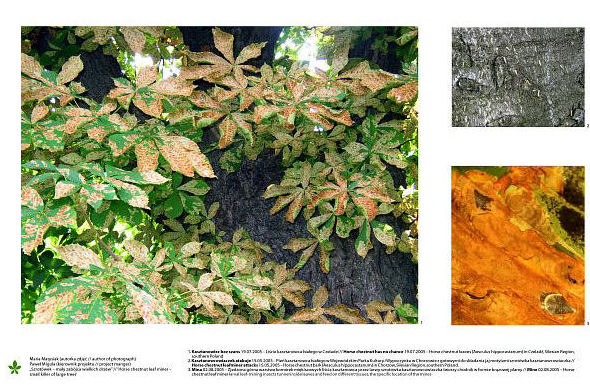 |
'Horse chestnut leaf miner - small killer of large trees'
'Antioxidative capabilities of three consecutive generations of Cameraria ohridella (Lepidoptera: Gracillariidae) under systemic insecticides (imidaclopride)' MARIA MATYSIAK (author of photograph)
PAWEŁ MIGULA (project manager)
University of Silesia, Faculty of Biology and Environmental Protection,
Department of Animal Physiology and Ecotoxicology; Bankowa 9, 40-007 Katowice
e-mail: mariazk@poczta.onet.pl
|

Description popularizing the research project
If it were not for the fact it is July and children do not pick up fallen chest nuts you would think it is autumn. Green is disappearing from palm-like leaves of chestnut trees. It gives way to small goldenbrown stains which in turn spread to cover the whole surface. So well-known leaves fade, roll up and look exactly like the ones fallen a year before. Soon they will fall as well. It is not a warming climate or pollution that ruins the trees in city greens and old palace garden avenues. The real perpetrator is an insect horse chestnut leaf miner. For the last few years after cold winters huge numbers of tiny butterflies have been emerging from their safe 'cocoons" burrowed in fallen leaves under a snow blanket. In spring they lay eggs in juicy leaves of chestnut trees. Then from the eggs tiny white caterpillars hatch. They eat parenchyma of a leaf leaving cavities between the upper and lower skin and after a few weeks they transform again. The newly emerged butterflies are not idle as well and before autumn comes the third generation of the insects storms the weakened trees. Our region was not spared from the plague too. The huge trees which shadow Silesian cemeteries and surround churches look grim in midsummer. They lose their fruit and in self-defense bloom again in September but to no avail.
The insect responsible for this disaster came to us from the Balkans and here it does not have any natural enemies. Moreover the time of emerging from a chrysalis is very short and its larvae are well hidden in safe corridors where they are not disturbed by birds and spiders. Only a man tries to save the trees injecting them with pesticides. Despite solving some mysteries of the insect the results are still unknown as new questions arise. Meanwhile the tiny insect still makes children and strollers anxious.
Abstract
Horse chestnut leaf miner (Cameraria ohridella, Deschka & Dimič) larvae are leaf miners spending the active stage of development eating leaf parenchyma Aesculus hippocastanum. Being seriously attacked, trees reduce their assimilative capacity. A series of counteractions were undertaken against the invader. The most common is the application of systemic insecticides (imidaclopride).
Our task was to check what antioxidative abilities of C. ohridella larvae are in relation to a part of the season (consecutive generations), self-defence capabilities of the host trees (the age of trees) and local conditions at sampling sites in the season when some of the trees were treated with imidaclopride.
Insects were collected from the trees treated with imidaclopride and not treated in the vegetation season 2005 at two sites: Czeladz (CZ), and Chorzow (CH) - Silesia, southern Poland. Caterpillars of a hyperphagic last stage were removed from the leaf parenchyma and their midgut was dissected. Activity of superoxide dismutase (SOD), catalase (CAT), glutathione peroxidase (GSTPx), karboxyloesterases (CarE), acetylocholinesterases (AChE) and gluthatione S-transferase (GST) were assayed.
This simply suggests that effective chemical control and sensitivity of this enzyme to insecticides can be crucial for the compound against the insect invaders, independently on the background conditions in their area of living. Patterns of detoxifying enzymes in this species are presented in a further study.

